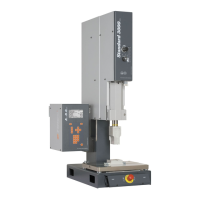
Do you have a question about the RINCO ULTRASONICS AG Standard 3000 and is the answer not in the manual?
| Brand | RINCO ULTRASONICS AG |
|---|---|
| Model | Standard 3000 |
| Category | Welding System |
| Language | English |
Explains the purpose, scope, and recommended use of the operating instructions.
Defines safety symbols and signal words used to convey hazard severity.
States limitations of liability and the scope of information provided in the manual.
Outlines the warranty conditions and obligations for RINCO ULTRASONICS AG.
Provides contact details for technical support and information on product feedback.
Provides an overview of key safety aspects for safe and trouble-free operation.
Defines the operator's fundamental obligations regarding workplace safety.
Details the qualifications and requirements for personnel operating the machine.
Lists the mandatory personal protective equipment required for safe operation.
Identifies residual risks that remain even after safety measures are implemented.
Explains the procedure for immediate machine shutdown in hazardous situations.
Explains the meaning and importance of symbols and pictograms used in the manual.
Provides a general overview of the complete system and its main components.
Describes the optional sound enclosure and its constituent parts.
Details the oscillator unit, a key functional component of the system.
Introduces the various controls and indicators on the welding press.
Presents a diagram of the menu structure for navigating the generator's interface.
Details the electrical connections required for the generator.
Explains the compressed air connection point on the welding press.
Describes the six sequential steps that constitute a welding cycle.
Guides users through setting up the machine for a new welding application.
Details various welding modes like Time, Travel, and Energy modes.
Covers essential safety precautions and PPE for transporting the machine.
Explains the function of packaging and handling procedures during delivery.
Provides instructions for safely moving packages using forklifts or lifting carts.
Outlines the conditions required for storing machine components and packages.
Details critical safety precautions to be observed during machine installation.
Specifies the environmental and spatial requirements for the machine's installation location.
Provides step-by-step instructions for the physical setup of the machine.
Details the essential procedures for making the electrical connections to the generator.
Explains the correct procedure for connecting the compressed air system.
Outlines crucial safety precautions for operating personnel and required PPE.
Details dangers from electric energy during operation and necessary safety measures.
Warns about hazards resulting from improper operation and required checks.
Describes risks from emissions and outlines required health and safety measures.
Addresses noise levels and the mandatory use of hearing protection.
Details mechanical hazards during operation, especially crushing risks.
Illustrates a typical application with ADG generator signals and process steps.
Shows ADG generator error signals, their meaning, and interpretation.
Explains ADG generator signals and process steps when using a sound enclosure.
Explains how to switch between saved welding applications (data sets).
Introduces process programming and the use of PIN codes for system access.
Describes advanced access to system parameters and amplitude measurement.
Introduces data analysis and statistics for performance tracking and quality control.
Details system setup procedures, including installing the oscillator system.
Lists essential pre-operational checks to be performed before starting the machine.
Provides instructions for powering on and initiating the machine's operation.
Explains the correct procedure for safely switching off the machine and its air supply.
Outlines critical safety precautions for personnel performing maintenance work.
Introduces the maintenance schedule for ensuring optimum and trouble-free operation.
Details the routine maintenance tasks to be performed at the end of each workday.
Lists the specific maintenance tasks that need to be performed every six months.
Details the maintenance tasks that are required to be performed on a yearly basis.
Provides instructions for cleaning the machine and its immediate working environment.
Details the procedures for servicing the compressed air maintenance unit.
Lists essential checks to perform after maintenance before restarting the machine.
Outlines safety precautions for personnel undertaking troubleshooting tasks.
Provides immediate actions to take when a fault presents an immediate risk.
Introduces the troubleshooting section and general error handling procedures.
Details generator errors indicated by LED1, their causes, and solutions.
Lists converter and application errors indicated by LED2, their causes, and solutions.
Details errors related to limit values indicated by LED3, their causes, and solutions.
Provides a classification of error codes based on their group or range.
Introduces tables detailing error messages, causes, and troubleshooting measures.
Lists errors specific to the press, including their causes and troubleshooting steps.
Lists errors related to the sound enclosure, their causes, and troubleshooting.
Lists errors associated with the digital input/output interfaces of the machine.
Lists errors indicating potential hardware failures or malfunctions.
Lists errors related to the RS232 serial communication interface.
Lists errors encountered during CANopen communication.
Lists warnings generated when limit values are approached or exceeded.
Lists warnings related to parameter settings or data set configurations.
Outlines essential checks after troubleshooting before restarting the machine.
Covers safety precautions for personnel involved in disassembly and disposal.
Lists the required personal protective equipment for disassembly and disposal work.
Provides critical safety warnings for electrical and pneumatic systems during disassembly.
Lists preparatory steps and safety checks before commencing disassembly.
Details the actual disassembly procedure, including necessary PPE and equipment.
Explains the correct procedures for disposing of the machine and its components.
Provides general technical specifications such as conformity and protection ratings.
Lists the physical dimensions and weights of the press and generator.
Details electrical power requirements and specifications for the generators.
Specifies the requirements and pressure limits for the pneumatic connection.
Lists the technical specifications for the press, including cylinder, stroke, and force.
Provides technical data for the generator and its associated control unit.
Details voltage levels and specifications for the machine's I/O signals.
Lists environmental requirements such as temperature, humidity, and installation height.
Introduces the pin assignments for the machine's connectors and interfaces.
Specifies the details needed when ordering replacement parts from the manufacturer.